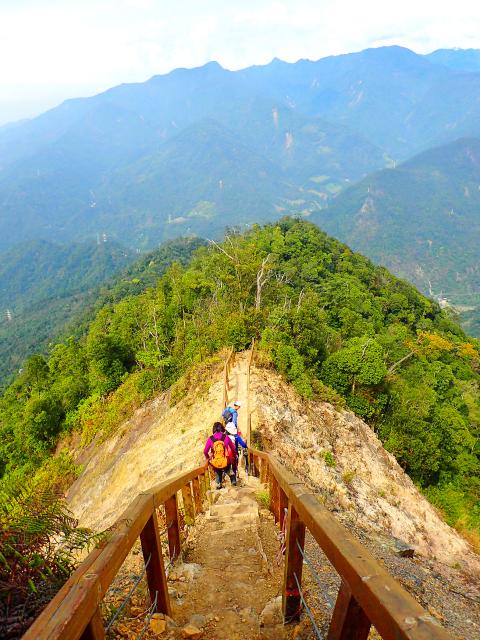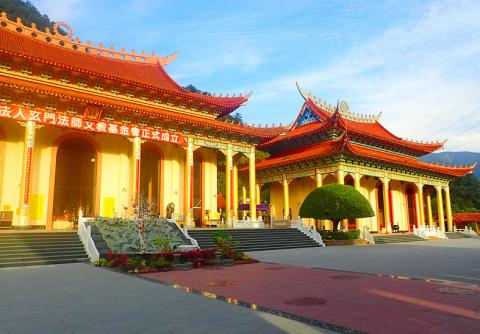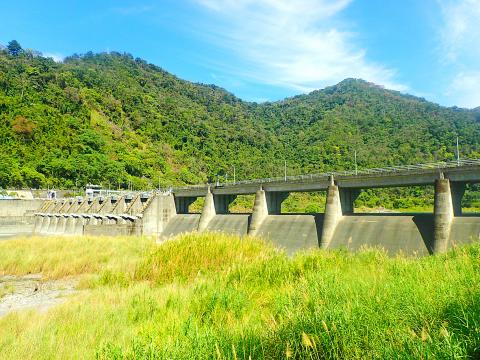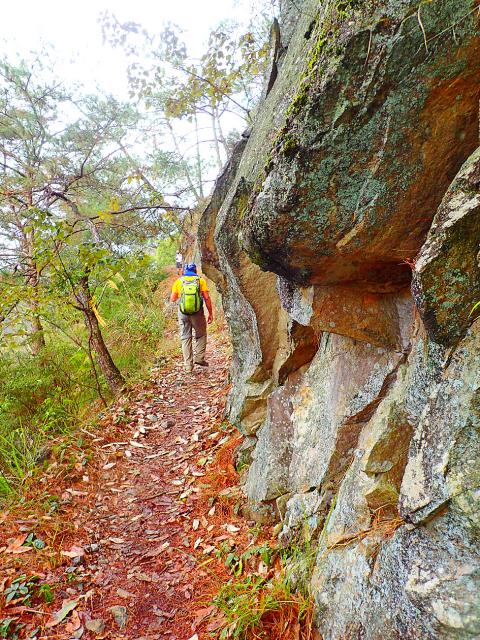With the sudden arrival of cooler temperatures, Taichung residents will be heading in droves to their city’s version of Beitou and Yangmingshan hot springs — Guguan (谷關).
Although probably enjoyed for centuries by local Atayal Aborigines, it was the Japanese who first developed the hot spring sources and founded the resort area we see today. Taipei residents used to the luxurious high standards of the capital’s hot spring resorts might find Guguan’s offerings a bit retro, but that’s part of their charm — affordable and with a spectacular location unmatched among any up north.
Guguan’s hot springs lie beside the Dajia River (大甲溪), which cuts a magnificent gorge through the western foothills of the Snow Mountain Range. There’s only one way to reach the resort — along the Central Cross-Island Highway (Provincial Highway No. 8). Once one of Taiwan’s best road trips, the highway connected Taichung with Hualien on the east coast, climbing over the Snow and Central Mountain Ranges. Today part of the western half remains closed, following catastrophic damage during the 921 Earthquake.

Photo: Richard Saunders
For hikers across the nation, the area is famed for the Seven Heroes of Guguan (谷關七雄), a series of nearby peaks ranging in height from 1.3km to over 2.3km. They’ve become popular (though strenuous) day hikes, all starting in or near Guguan. Curiously, the seven peaks have both Japanese and Chinese names (Guguan was one of three main logging areas during the Japanese era). All seven have well-maintained, easy-to-follow trails, but unless you’re a strong hiker, pick a few longer hikes around Yangmingshan’s peaks before attempting any of them.
Serious hikers will want to complete all seven peaks, which would take at least a month of weekends and a considerable supply of energy. Less ambitious hikers should start with the two distinctive and less strenuous peaks described below, and move onto climbing the tougher ones later.
Dongmao Mountain (東卯山; 1,690m) is the shapeliest of the seven peaks, with a striking pyramidal profile. Surprisingly, it’s by a good whack the easiest to climb, courtesy of the long, zigzagging trail which reaches up to the peak. With 900m of vertical ascent from trailhead to summit, it’s no walk in the park, but it’s probably the best choice for a first Hero.

Photo: Richard Saunders
The trailhead is at Guguan Monastery (谷關大道院), nine kilometers west of Guguan village, which offers tourists simple but comfortable dormitory accommodation (free, but leave a donation). It’s a popular base to stay among weekend hikers bagging a couple of the Heroes, so if you want to stay, book ahead.
The route to the summit first follows a surfaced track that winds uphill past the huge monastery complex. It soon becomes a dirt trail, lying along the base of a cliff for a while before zigzagging gently uphill through the forest. Only the last few hundred meters of the trail is steep, with an easy rock face to scale (with the help of a rope), then a short scramble up a scree of loose rocks to reach the peak. The reward from the boulder-strewn summit is a magnificent 270-degree panorama over greater Taichung City — easily the finest view of the Seven Heroes.
Adventure lovers might prefer to approach the top via a more exciting route that branches left (marked by plastic ribbons tied to trees), and climbs along the rocky knife-edge spine of the ridge to the peak.

Photo: Richard Saunders
Allow five to six hours for the return hike.
Directly opposite Dongmao Mountain looms Baimao Mountain (白毛山; 1,522m), a more arduous but equally fine hike with expansive views from the peak. The trailhead is Maanba Dam (馬鞍霸), right beside Provincial Highway No. 8, a kilometer or so west of Guguan Monastery. Public vehicles can’t use the narrow road that crosses the dam, but it’s doable by scooter, which cuts off the first few kilometers of the hike. Turn right at the end of the dam and follow the road on the far side downstream beside the Dajia River (大甲溪), keeping to the dusty road on the left, uphill, to the trailhead at the end of the road.
It’s a long and steep climb, much of it through forest and just before the peak there’s a riveting short stretch along a short knife-edge ridge, giving incredible views in both directions in clear weather.

Photo: Richard Saunders
Allow six to seven hours for the 14km-long round trip.

This month the government ordered a one-year block of Xiaohongshu (小紅書) or Rednote, a Chinese social media platform with more than 3 million users in Taiwan. The government pointed to widespread fraud activity on the platform, along with cybersecurity failures. Officials said that they had reached out to the company and asked it to change. However, they received no response. The pro-China parties, the Chinese Nationalist Party (KMT) and Taiwan People’s Party (TPP), immediately swung into action, denouncing the ban as an attack on free speech. This “free speech” claim was then echoed by the People’s Republic of China (PRC),

Exceptions to the rule are sometimes revealing. For a brief few years, there was an emerging ideological split between the Democratic Progressive Party (DPP) and Chinese Nationalist Party (KMT) that appeared to be pushing the DPP in a direction that would be considered more liberal, and the KMT more conservative. In the previous column, “The KMT-DPP’s bureaucrat-led developmental state” (Dec. 11, page 12), we examined how Taiwan’s democratic system developed, and how both the two main parties largely accepted a similar consensus on how Taiwan should be run domestically and did not split along the left-right lines more familiar in

Many people in Taiwan first learned about universal basic income (UBI) — the idea that the government should provide regular, no-strings-attached payments to each citizen — in 2019. While seeking the Democratic nomination for the 2020 US presidential election, Andrew Yang, a politician of Taiwanese descent, said that, if elected, he’d institute a UBI of US$1,000 per month to “get the economic boot off of people’s throats, allowing them to lift their heads up, breathe, and get excited for the future.” His campaign petered out, but the concept of UBI hasn’t gone away. Throughout the industrialized world, there are fears that

Most heroes are remembered for the battles they fought. Taiwan’s Black Bat Squadron is remembered for flying into Chinese airspace 838 times between 1953 and 1967, and for the 148 men whose sacrifice bought the intelligence that kept Taiwan secure. Two-thirds of the squadron died carrying out missions most people wouldn’t learn about for another 40 years. The squadron lost 15 aircraft and 148 crew members over those 14 years, making it the deadliest unit in Taiwan’s military history by casualty rate. They flew at night, often at low altitudes, straight into some of the most heavily defended airspace in Asia.